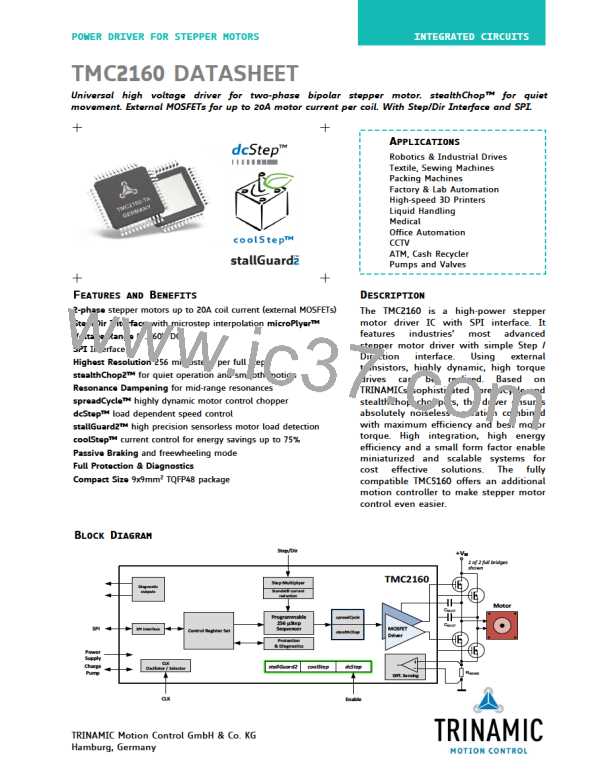TMC2160 DATASHEET (Rev. 1.02 / 2018-NOV-19)
8
1.4 Moving the Motor
1.4.1 STEP/DIR Interface
The motor is controlled by a step and direction input. Active edges on the STEP input can be rising
edges or both rising and falling edges as controlled by another mode bit (dedge). Using both edges
cuts the toggle rate of the STEP signal in half, which is useful for communication over slow interfaces
such as optically isolated interfaces. On each active edge, the state sampled from the DIR input
determines whether to step forward or back. Each step can be a fullstep or a microstep, in which
there are 2, 4, 8, 16, 32, 64, 128, or 256 microsteps per fullstep. A step impulse with a low state on
DIR increases the microstep counter and a high state decreases the counter by an amount controlled
by the microstep resolution. An internal table translates the counter value into the sine and cosine
values which control the motor current for microstepping.
1.4.2 SPI direct mode
The direct mode allows control of both motor coil currents and polarity via SPI. It mainly is intended
for use with a dedicated external motion controller IC with integrated sequencer. The sequencer
applies sine and cosine waves to the motor coils. This mode is specially designed for combination
with the TMC4361 motion controller.
1.5 Automatic Standstill Power Down
An automatic current reduction drastically reduces application power dissipation and cooling
requirements. Modify stand still current, delay time and decay via register settings. Automatic
freewheeling and passive motor braking are provided as an option for stand still. Passive braking
reduces motor standstill power consumption to zero, while still providing effective dampening and
braking! An option for faster detection of standstill is provided for use with highly frequent motion
commands.
STEP
Standstill flag
(stst)
CURRENT
IRUN
IHOLD
t
standstill delay TPOWERDOWN IHOLDDELAY
2^20 / 2^18 clocks power down power down
RMS motor current trace
(faststandstill)
delay time
ramp time
Figure 1.3 Automatic Motor Current Power Down
1.6 stealthChop2 & spreadCycle Driver
stealthChop is a voltage chopper based principle. It especially guarantees that the motor is absolutely
quiet in standstill and in slow motion, except for noise generated by ball bearings. Unlike other
voltage mode choppers, stealthChop2 does not require any configuration. It automatically learns the
best settings during the first motion after power up and further optimizes the settings in subsequent
motions. An initial homing sequence is sufficient for learning. Optionally, initial learning parameters
can be pre-configured via the interface. stealthChop2 allows high motor dynamics, by reacting at once
to a change of motor velocity.
For highest dynamic applications, spreadCycle is an option to stealthChop2. It can be enabled via
input pin (standalone mode) or via SPI interface. stealthChop2 and spreadCycle may even be used in a
combined configuration for the best of both worlds: stealthChop2 for no-noise stand still, silent and
smooth performance, spreadCycle at higher velocity for high dynamics and highest peak velocity at
low vibration.
www.trinamic.com

 TRINAMIC [ TRINAMIC MOTION CONTROL GMBH & CO. KG. ]
TRINAMIC [ TRINAMIC MOTION CONTROL GMBH & CO. KG. ]